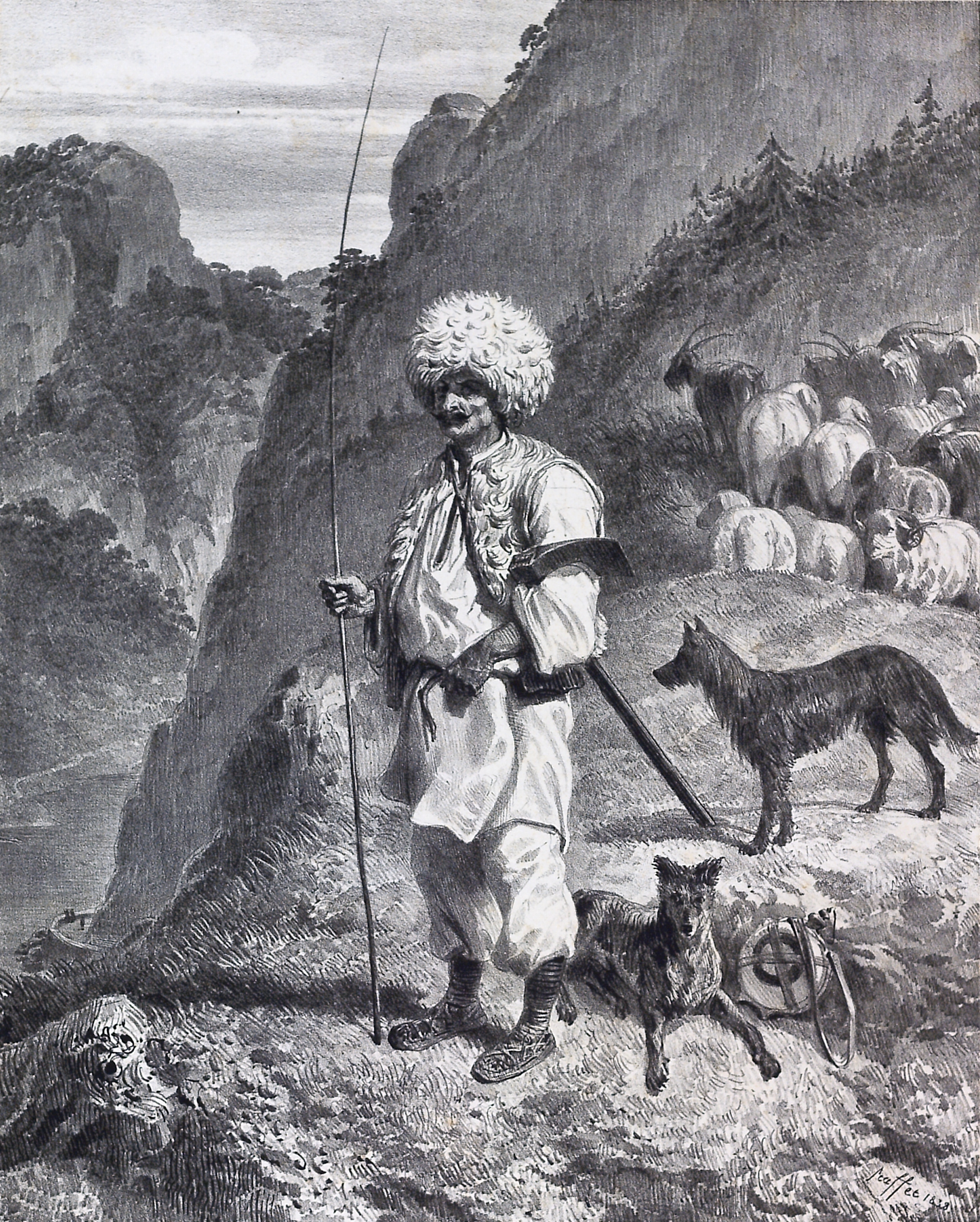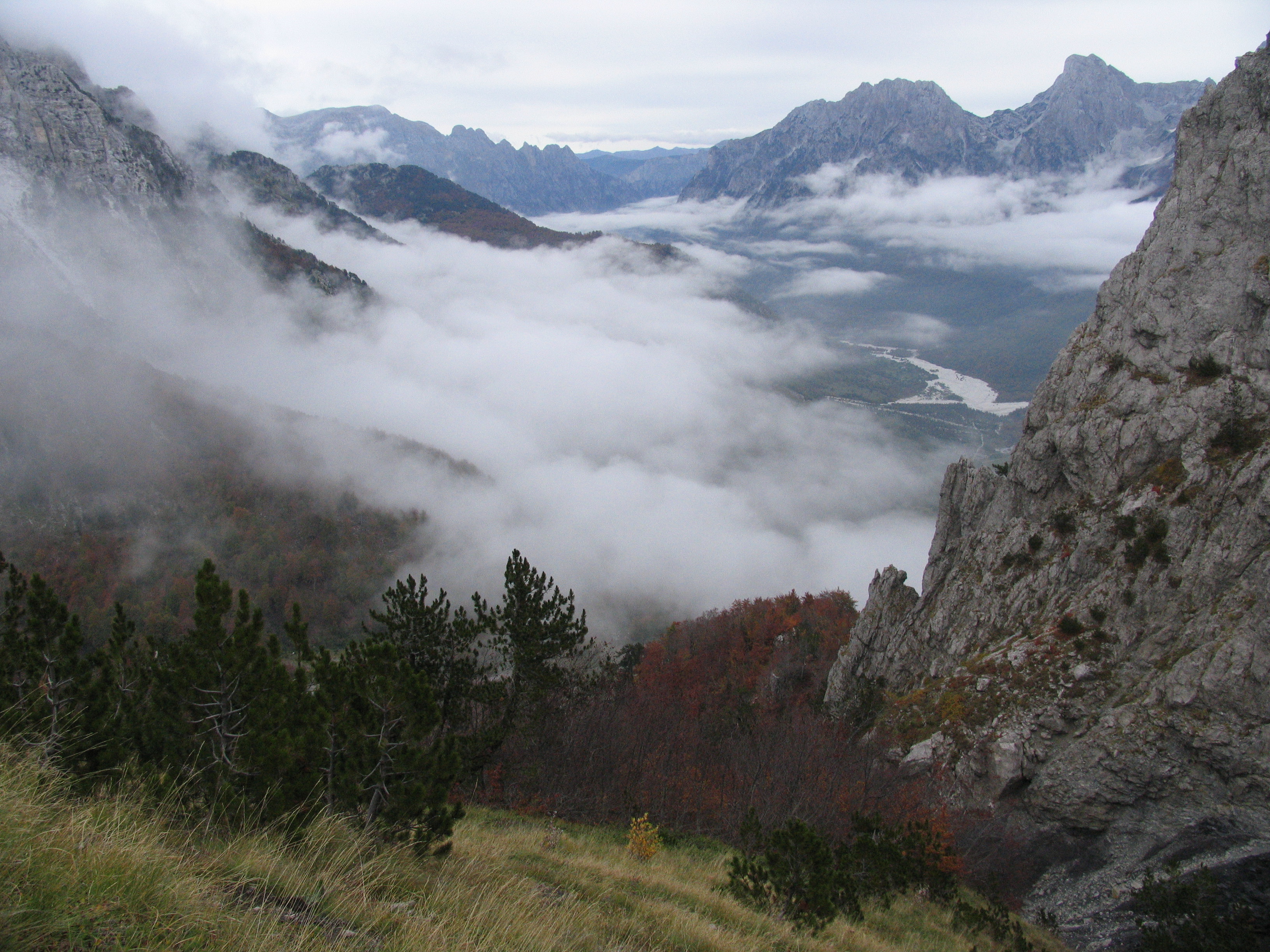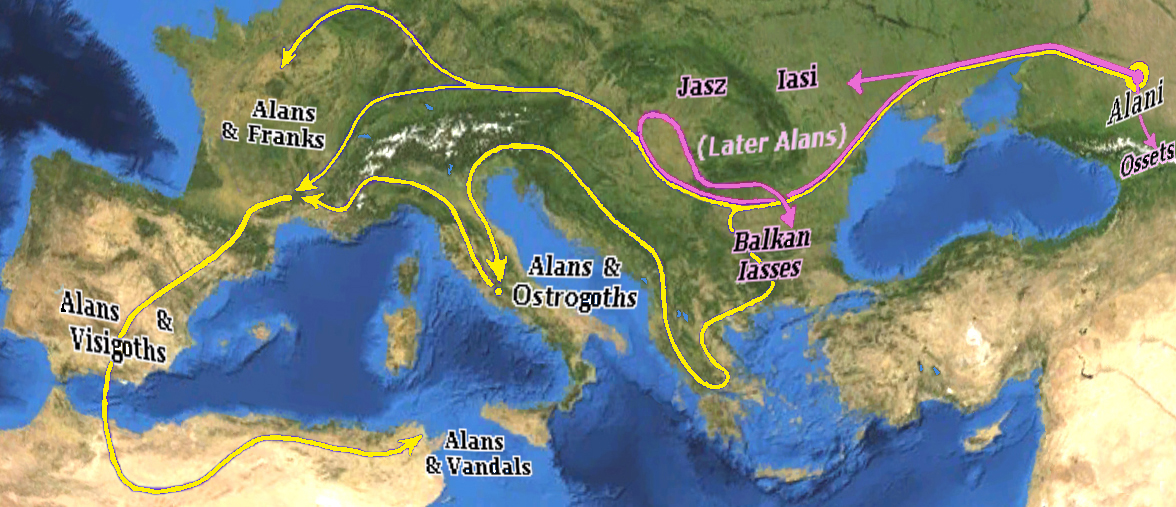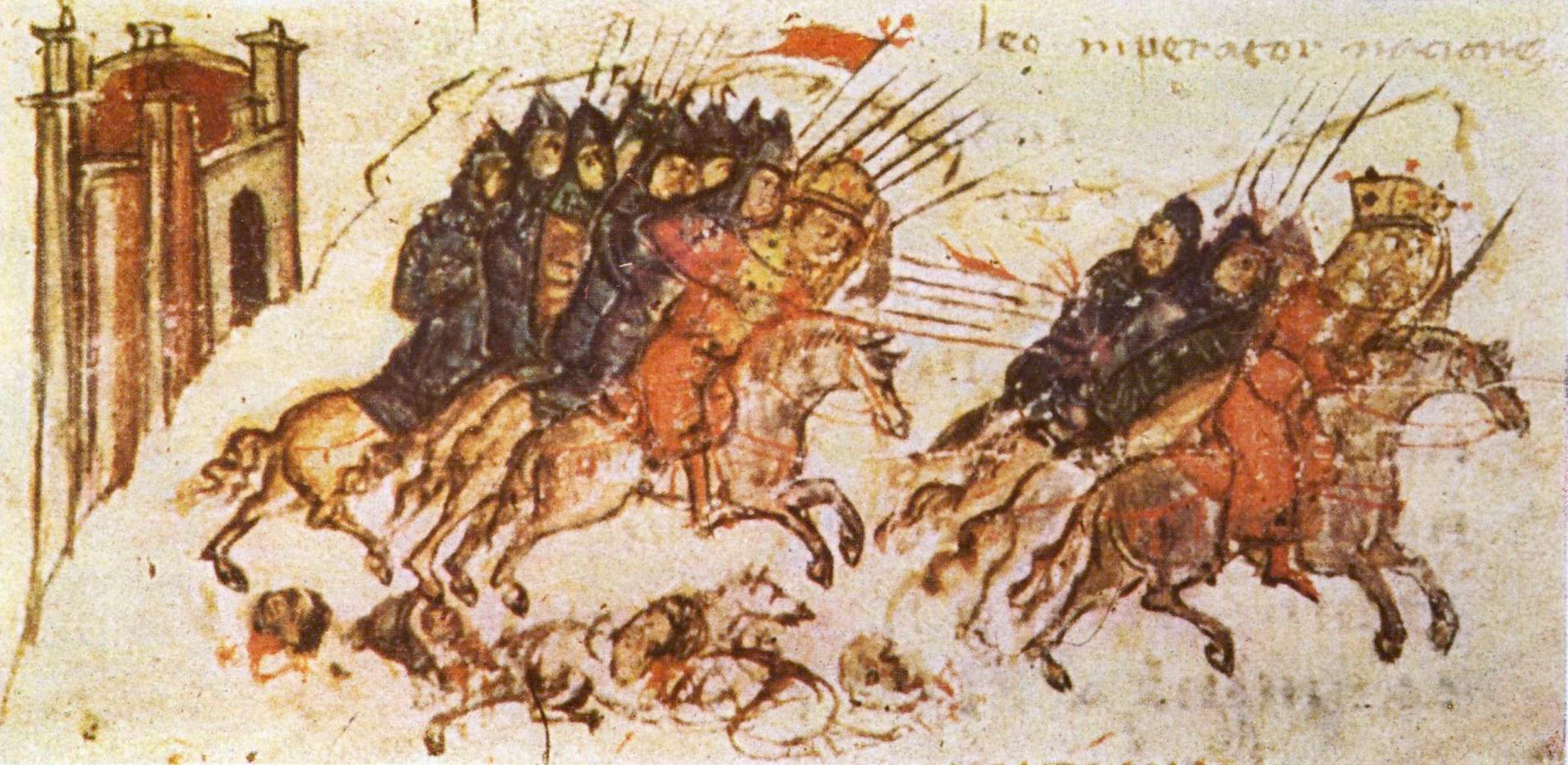|
Shepherd's Axe
The shepherd's axe is a long thin light axe of Eurasian origin used in past centuries by shepherds in the Carpathian Mountains and in other territories which comprise today Slovakia, Czech Republic, Poland, Ukraine, Romania and Hungary. The features of a shepherd's axe combine a tool with a walking stick, that could be used as a light weapon. It has symbolic historical and cultural connotations and is still used as a prop in many traditional dances, for example the odzemek. Names Depending on the language, the axe is called as follows: ; ; Polish (depending on the region): ciupaga, rąbanica, obuszek, cekanka, wałaszka; ; ; ; ). Appearance A shepherd's axe is a light axe with a long and straight wooden shaft, often with a metal butt. The length of the shaft is usually slightly more than 1 metre. The shafts were usually engraved as their owners had plenty of time for crafting. A small metal head-piece is sharp on one side while the other side is flat and can be use ... [...More Info...] [...Related Items...] OR: [Wikipedia] [Google] [Baidu] |
Scythian
The Scythians ( or ) or Scyths (, but note Scytho- () in composition) and sometimes also referred to as the Pontic Scythians, were an ancient Eastern Iranian equestrian nomadic people who had migrated during the 9th to 8th centuries BC from Central Asia to the Pontic Steppe in modern-day Ukraine and Southern Russia, where they remained established from the 7th century BC until the 3rd century BC. Skilled in mounted warfare, the Scythians replaced the Agathyrsi and the Cimmerians as the dominant power on the western Eurasian Steppe in the 8th century BC. In the 7th century BC, the Scythians crossed the Caucasus Mountains and frequently raided West Asia along with the Cimmerians. After being expelled from West Asia by the Medes, the Scythians retreated back into the Pontic Steppe in the 6th century BC, and were later conquered by the Sarmatians in the 3rd to 2nd centuries BC. By the 3rd century AD, last remnants of the Scythians were overwhelmed by the Goths, and by th ... [...More Info...] [...Related Items...] OR: [Wikipedia] [Google] [Baidu] |
Dinaric Mountains
The Dinaric Alps (), also Dinarides, are a mountain range in Southern and Southcentral Europe, separating the continental Balkan Peninsula from the Adriatic Sea. They stretch from Italy in the northwest through Slovenia, Croatia, Bosnia and Herzegovina, Serbia, Montenegro, and Kosovo to Albania in the southeast. The Dinaric Alps extend for approximately along the western Balkan Peninsula from the Julian Alps of the northeast Italy, downwards to the Šar and Korab massif, where their direction changes. The Accursed Mountains are the highest section of the entire Dinaric Alps; this section stretches from Albania to Kosovo and eastern Montenegro. Maja Jezercë, standing at above the Adriatic, is the highest peak and is located in Albania. The Dinaric Alps are one of the most rugged and extensive mountainous areas of Europe, alongside the Caucasus Mountains, Alps, Pyrenees, Carpathian Mountains and Scandinavian Mountains. They are formed largely of Mesozoic and Cenozoic sedimen ... [...More Info...] [...Related Items...] OR: [Wikipedia] [Google] [Baidu] |
Central Europe
Central Europe is a geographical region of Europe between Eastern Europe, Eastern, Southern Europe, Southern, Western Europe, Western and Northern Europe, Northern Europe. Central Europe is known for its cultural diversity; however, countries in this region also share some historical and cultural similarities. The region is variously defined, but it’s minimum definition could be considered of consisting of Austria, Bosnia and Herzegovina, Croatia, the Czech Republic, eastern France, Germany, Liechtenstein, Luxembourg, Poland, Slovakia, Slovenia and Switzerland. But also the Baltic States, the Alsace in north-east France, and South Tyrol, northern Belluno , and Friuli-Venezia Giulia in north-east Italy are culturally usually considered to be part of Central Europe. From the early 16th century until the early 18th century, parts of Croatia and Hungary were ruled by the Ottoman Empire. During the 17th century, the empire also occupied southern parts of present-day Slovakia. During ... [...More Info...] [...Related Items...] OR: [Wikipedia] [Google] [Baidu] |
Vlachs
Vlach ( ), also Wallachian and many other variants, is a term and exonym used from the Middle Ages until the Modern Era to designate speakers of Eastern Romance languages living in Southeast Europe—south of the Danube (the Balkan peninsula) and north of the Danube. Although it has also been used to name present-day Romanians, the term "Vlach" today refers primarily to speakers of the Eastern Romance languages who live south of the Danube, in Albania, Bulgaria, northern Greece, North Macedonia and eastern Serbia. These people include the ethnic groups of the Aromanians, the Megleno-Romanians and, in Serbia, the Timok Romanians. The term also became a synonym in the Balkans for the social category of shepherds, and was also used for non-Romance-speaking peoples, in recent times in the western Balkans derogatively. The term is also used to refer to the ethnographic group of Moravian Vlachs who speak a Slavic language but originate from Romanians, as well as for Morlachs ... [...More Info...] [...Related Items...] OR: [Wikipedia] [Google] [Baidu] |
Slavs
The Slavs or Slavic people are groups of people who speak Slavic languages. Slavs are geographically distributed throughout the northern parts of Eurasia; they predominantly inhabit Central Europe, Eastern Europe, Southeastern Europe, and Northern Asia, though there is a large Slavic minority scattered across the Baltic states and Central Asia, and a substantial Slavic diaspora in the Americas, Western Europe, and Northern Europe. Early Slavs lived during the Migration Period and the Early Middle Ages (approximately from the 5th to the 10th century AD), and came to control large parts of Central, Eastern, and Southeast Europe between the sixth and seventh centuries. Beginning in the 7th century, they were gradually Christianized. By the 12th century, they formed the core population of a number of medieval Christian states: East Slavs in the Kievan Rus', South Slavs in the Bulgarian Empire, the Principality of Serbia, the Duchy of Croatia and the Banate of B ... [...More Info...] [...Related Items...] OR: [Wikipedia] [Google] [Baidu] |
Alans
The Alans () were an ancient and medieval Iranian peoples, Iranic Eurasian nomads, nomadic pastoral people who migrated to what is today North Caucasus – while some continued on to Europe and later North Africa. They are generally regarded as part of the Sarmatians, and possibly related to the Massagetae. Modern historians have connected the Alans with the Central Asian Yancai of China, Chinese sources and with the Aorsi of Ancient Rome, Roman sources. Having migrated westwards and becoming dominant among the Sarmatians on the Pontic–Caspian steppe, the Alans are mentioned by Roman sources in the . At that time they had settled the region north of the Black Sea and frequently raided the Parthian Empire and the South Caucasus provinces of the Roman Empire. From the Goths broke their power on the Pontic Steppe, thereby assimilating a sizeable portion of the associated Alans. Upon the Huns, Hunnic defeat of the Goths on the Pontic Steppe around , many of the Alans migrated w ... [...More Info...] [...Related Items...] OR: [Wikipedia] [Google] [Baidu] |
Bulgars
The Bulgars (also Bulghars, Bulgari, Bolgars, Bolghars, Bolgari, Proto-Bulgarians) were Turkic peoples, Turkic Nomad, semi-nomadic warrior tribes that flourished in the Pontic–Caspian steppe and the Volga region between the 5th and 7th centuries. They became known as Eurasian nomads, nomadic equestrians in the Volga-Ural region, but some researchers trace Bulgar ethnic roots to Central Asia. During their westward migration across the Eurasian Steppe, the Bulgar tribes absorbed other tribal groups and cultural influences in a process of ethnogenesis, including Iranian peoples, Iranic, Finno-Ugric peoples, Finno-Ugric, and Huns, Hunnic tribes. The Bulgars spoke a Turkic languages, Turkic language, the Bulgar language of the Oghur languages, Oghuric branch. They preserved the military titles, organization, and customs of Eurasian steppes as well as pagan shamanism and belief in the sky deity Tengri, Tangra. The Bulgars became semi-sedentary during the 7th century in the Pontic- ... [...More Info...] [...Related Items...] OR: [Wikipedia] [Google] [Baidu] |
Hungarian Language
Hungarian, or Magyar (, ), is an Ugric language of the Uralic language family spoken in Hungary and parts of several neighboring countries. It is the official language of Hungary and one of the 24 official languages of the European Union. Outside Hungary, it is also spoken by Hungarians, Hungarian communities in southern Slovakia, western Ukraine (Zakarpattia Oblast, Transcarpathia), central and western Romania (Transylvania), northern Serbia (Vojvodina), northern Croatia, northeastern Slovenia (Prekmurje), and eastern Austria (Burgenland). It is also spoken by Hungarian diaspora communities worldwide, especially in North America (particularly the Hungarian Americans, United States and Canada) and Israel. With 14 million speakers, it is the Uralic family's most widely spoken language. Classification Hungarian is a member of the Uralic language family. Linguistic connections between Hungarian and other Uralic languages were noticed in the 1670s, and the family's existenc ... [...More Info...] [...Related Items...] OR: [Wikipedia] [Google] [Baidu] |
Hungarian Academy Of Sciences
The Hungarian Academy of Sciences ( , MTA) is Hungary’s foremost and most prestigious learned society. Its headquarters are located along the banks of the Danube in Budapest, between Széchenyi rakpart and Akadémia utca. The Academy's primary functions include the advancement of scientific knowledge, the dissemination of research findings, the support of research and development, and the representation of science in Hungary both domestically and around the world. History The origins of the Hungarian Academy of Sciences date back to 1825, when Count István Széchenyi offered one year's income from his estate to establish a ''Learned Society''. He made this offer during a session of the Diet in Pressburg (Pozsony, now Bratislava), then the seat of the Hungarian Parliament. Inspired by his gesture, other delegates soon followed suit. The Society’s mission was defined as the development of the Hungarian language and the promotion of sciences and the arts in the Hungarian l ... [...More Info...] [...Related Items...] OR: [Wikipedia] [Google] [Baidu] |
Hungarian Conquest Of The Carpathian Basin
The Hungarian conquest of the Carpathian Basin, also known as the Hungarian conquest or the Hungarian land-taking (), was a series of historical events ending with the settlement of the Hungarians in Central Europe in the late 9th and early 10th century. Before the arrival of the Hungarians, three early medieval powers, the First Bulgarian Empire, East Francia, and Great Moravia, Moravia, had fought each other for control of the Pannonian Basin, Carpathian Basin. They occasionally hired Hungarian horsemen as soldiers. Therefore, the Hungarians who dwelt on the Pontic–Caspian steppe, Pontic-Caspian Steppe east of the Carpathian Mountains were familiar with what would become their homeland when their conquest started. The Hungarian conquest started in the context of a "late or 'small' Migration Period, migration of peoples". The Hungarians took possession of the Pannonian Basin, Carpathian Basin in a pre-planned manner, with a long move-in between 862–895. Other theories asser ... [...More Info...] [...Related Items...] OR: [Wikipedia] [Google] [Baidu] |
Magyars
Hungarians, also known as Magyars, are an ethnic group native to Hungary (), who share a common culture, language and history. They also have a notable presence in former parts of the Kingdom of Hungary. The Hungarian language belongs to the Ugric branch of the Uralic language family, alongside the Khanty and Mansi languages. There are an estimated 14.5 million ethnic Hungarians and their descendants worldwide, of whom 9.6 million live in today's Hungary. About 2 million Hungarians live in areas that were part of the Kingdom of Hungary before the Treaty of Trianon in 1920 and are now parts of Hungary's seven neighbouring countries, Slovakia, Ukraine, Romania, Serbia, Croatia, Slovenia, and Austria. In addition, significant groups of people with Hungarian ancestry live in various other parts of the world, most of them in the United States, Canada, Germany, France, the United Kingdom, Chile, Brazil, Australia, and Argentina, and therefore constitute the Hungarian diaspo ... [...More Info...] [...Related Items...] OR: [Wikipedia] [Google] [Baidu] |










